Evaluation of the Interface Strength in the Abaca-Fiber-Reinforced Bio-Polyethylene Composites
Abstract
:1. Introduction
2. Materials and Methods
2.1. Materials
2.2. Composite Fabrication
2.3. Dog Bone Specimen Obtention and Tensile Test of the Specimens
2.4. Specimen 3D Model and Injection Molding Simulation
2.5. Morphological Analysis of the Reinforcements
3. Results and Discussion
3.1. Experimental Results
3.2. Micromechanical Modeling
4. Conclusions
Author Contributions
Funding
Institutional Review Board Statement
Informed Consent Statement
Data Availability Statement
Acknowledgments
Conflicts of Interest
References
- Das, S.C.; La Rosa, A.D.; Grammatikos, S.A. Life cycle assessment of plant fibers and their composites. In Plant Fibers, their Composites, and Applications; Elsevier: Amsterdam, The Netherlands, 2022; pp. 457–484. [Google Scholar]
- Walker, S.; Rothman, R. Life cycle assessment of bio-based and fossil-based plastic: A review. J. Clean. Prod. 2020, 261, 121158. [Google Scholar] [CrossRef]
- Spierling, S.; Röttger, C.; Venkatachalam, V.; Mudersbach, M.; Herrmann, C.; Endres, H.-J. Bio-based Plastics—A Building Block for the Circular Economy? Procedia CIRP 2018, 69, 573–578. [Google Scholar] [CrossRef]
- Milani, A.S.; Eskicioglu, C.; Robles, K.; Bujun, K.; Hosseini-Nasab, H. Multiple criteria decision making with life cycle assessment for material selection of composites. Express Polym. Lett. 2011, 5, 1062–1074. [Google Scholar] [CrossRef]
- Rebitzer, G.; Ekvall, T.; Frischknecht, R.; Hunkeler, D.; Norris, G.; Rydberg, T.; Schmidt, W.P.; Suh, S.; Weidema, B.P.; Pennington, D.W. Life cycle assessment Part 1: Framework, goal and scope definition, inventory analysis, and applications. Environ. Int. 2004, 30, 701–720. [Google Scholar] [CrossRef]
- Pandey, J.; Nagarajan, V.; Mohanty, A.; Misra, M. Commercial potential and competitiveness of natural fiber composites. In Biocomposites; Elsevier: Amsterdam, The Netherlands, 2015; pp. 1–15. [Google Scholar]
- Kumar, S.; Manna, A.; Dang, R.J.M.T.P. A review on applications of natural Fiber-Reinforced composites (NFRCs). Mater. Today Proc. 2022, 50, 1632–1636. [Google Scholar] [CrossRef]
- Lau, K.-t.; Hoi-yan Cheung, K.; Hui, D. Natural fiber composites. Compos. Part B Eng. 2009, 40, 591–593. [Google Scholar] [CrossRef]
- Ma, X.F.; Yu, J.G.; Kennedy, J.F. Studies on the properties of natural fibers-reinforced thermoplastic starch composites. Carbohydr. Polym. 2005, 62, 19–24. [Google Scholar] [CrossRef]
- Malkapuram, R.; Kumar, V.; Negi, Y.S. Recent Development in Natural Fiber Reinforced Polypropylene Composites. J. Reinf. Plast. Compos. 2009, 28, 1169–1189. [Google Scholar] [CrossRef]
- Mohanty, A.K.; Misra, M.; Drzal, L.T. Sustainable bio-composites from renewable resources: Opportunities and challenges in the green materials world. J. Polym. Environ. 2002, 10, 19–26. [Google Scholar] [CrossRef]
- Ashby, M.F.; Cebon, D. Materials selection in mechanical design. J. Phys. 1993, 3, C7-1. [Google Scholar] [CrossRef] [Green Version]
- Sinha, A.K.; Bhattacharya, S.; Narang, H.K. Abaca fibre reinforced polymer composites: A review. J. Mater. Sci. 2021, 56, 4569–4587. [Google Scholar] [CrossRef]
- Delicano, J.A. A review on abaca fiber reinforced composites. Compos. Interfaces 2018, 25, 1039–1066. [Google Scholar] [CrossRef]
- Granda, L.A.; Espinach, F.X.; Lopez, F.; Garcia, J.C.; Delgado-Aguilar, M.; Mutje, P. Semichemical fibres of Leucaena collinsii reinforced polypropylene: Macromechanical and micromechanical analysis. Compos. Pt. B-Eng. 2016, 91, 384–391. [Google Scholar] [CrossRef]
- Výbohová, E.; Kučerová, V.; Andor, T.; Balážová, Ž.; Veľková, V. The effect of heat treatment on the chemical composition of ash wood. BioResources 2018, 13, 8394–8408. [Google Scholar] [CrossRef]
- Sain, M.; Suhara, P.; Law, S.; Bouilloux, A. Interface modification and mechanical properties of natural fiber-polyolefin composite products. J. Reinf. Plast. Compos. 2005, 24, 121–130. [Google Scholar] [CrossRef]
- Piggott, M. The effect of the interface/interphase on fiber composite properties. Polym. Compos. 1987, 8, 291–297. [Google Scholar] [CrossRef]
- Charlet, K.; Béakou, A. Mechanical properties of interfaces within a flax bundle–Part I: Experimental analysis. Int. J. Adhes. Adhes. 2011, 31, 875–881. [Google Scholar] [CrossRef]
- Asumani, O.M.L.; Reid, R.G.; Paskaramoorthy, R. The effects of alkali-silane treatment on the tensile and flexural properties of short fibre non-woven kenaf reinforced polypropylene composites. Compos. Part A-Appl. Sci. Manuf. 2012, 43, 1431–1440. [Google Scholar] [CrossRef]
- Bledzki, A.K.; Fink, H.P.; Specht, K. Unidirectional hemp and flax EP- and PP-composites: Influence of defined fiber treatments. J. Appl. Polym. Sci. 2004, 93, 2150–2156. [Google Scholar] [CrossRef]
- Cao, Y.; Shibata, S.; Fukumoto, I. Mechanical properties of biodegradable composites reinforced with bagasse fibre before and after alkali treatments. Compos. Part A-Appl. Sci. Manuf. 2006, 37, 423–429. [Google Scholar] [CrossRef]
- Colom, X.; Carrasco, F.; Pages, P.; Canavate, J. Effects of different treatments on the interface of HDPE/lignocellulosic fiber composites. Compos. Sci. Technol. 2003, 63, 161–169. [Google Scholar] [CrossRef]
- Karthi, N.; Kumaresan, K.; Sathish, S.; Gokulkumar, S.; Prabhu, L.; Vigneshkumar, N. An overview: Natural fiber reinforced hybrid composites, chemical treatments and application areas. Mater. Today Proc. 2020, 27, 2828–2834. [Google Scholar] [CrossRef]
- Oliver-Ortega, H.; Julian, F.; Espinach, F.X.; Tarrés, Q.; Ardanuy, M.; Mutjé, P. Research on the use of lignocellulosic fibers reinforced bio-polyamide 11 with composites for automotive parts: Car door handle case study. J. Clean. Prod. 2019, 226, 64–73. [Google Scholar] [CrossRef]
- Kumar, R.; Ul Haq, M.I.; Raina, A.; Anand, A. Industrial applications of natural fibre-reinforced polymer composites—Challenges and opportunities. Int. J. Sustain. Eng. 2019, 12, 212–220. [Google Scholar] [CrossRef]
- Delgado-Aguilar, M.; Tarres, Q.; Marques, M.d.F.V.; Espinach, F.X.; Julian, F.; Mutje, P.; Vilaseca, F. Explorative Study on the Use of Curaua Reinforced Polypropylene Composites for the Automotive Industry. Materials 2019, 12, 4185. [Google Scholar] [CrossRef] [PubMed] [Green Version]
- Averous, L.; Fringant, C.; Moro, L. Starch-based biodegradable materials suitable for thermoforming packaging. Starch-Starke 2001, 53, 368–371. [Google Scholar] [CrossRef]
- Ferreira, F.V.; Pinheiro, I.F.; Mariano, M.; Cividanes, L.S.; Costa, J.C.; Nascimento, N.R.; Kimura, S.P.; Neto, J.C.; Lona, L.M. Environmentally friendly polymer composites based on PBAT reinforced with natural fibers from the amazon forest. Polym. Compos. 2019, 40, 3351–3360. [Google Scholar] [CrossRef]
- Balart, J.F.; Fombuena, V.; Fenollar, O.; Boronat, T.; Sánchez-Nacher, L. Processing and characterization of high environmental efficiency composites based on PLA and hazelnut shell flour (HSF) with biobased plasticizers derived from epoxidized linseed oil (ELO). Compos. Part B Eng. 2016, 86, 168–177. [Google Scholar] [CrossRef]
- Bodros, E.; Pillin, I.; Montrelay, N.; Baley, C. Could biopolymers reinforced by randomly scattered flax fibre be used in structural applications? Compos. Sci. Technol. 2007, 67, 462–470. [Google Scholar] [CrossRef]
- Flores-Hernández, C.; Colín-Cruz, A.; Velasco-Santos, C.; Castaño, V.; Rivera-Armenta, J.; Almendarez-Camarillo, A.; García-Casillas, P.; Martínez-Hernández, A. All Green Composites from Fully Renewable Biopolymers: Chitosan-Starch Reinforced with Keratin from Feathers. Polymers 2014, 6, 686. [Google Scholar] [CrossRef] [Green Version]
- Islam, M.Z.; Sarker, M.E.; Rahman, M.M.; Islam, M.R.; Ahmed, A.F.; Mahmud, M.S.; Syduzzaman, M. Green composites from natural fibers and biopolymers: A review on processing, properties, and applications. J. Reinf. Plast. Compos. 2022, 41, 526–557. [Google Scholar] [CrossRef]
- Siracusa, V.; Blanco, I. Bio-polyethylene (Bio-PE), Bio-polypropylene (Bio-PP) and Bio-poly (ethylene terephthalate)(Bio-PET): Recent developments in bio-based polymers analogous to petroleum-derived ones for packaging and engineering applications. Polymers 2020, 12, 1641. [Google Scholar] [CrossRef]
- Gowthaman, N.; Lim, H.; Sreeraj, T.; Amalraj, A.; Gopi, S. Advantages of biopolymers over synthetic polymers: Social, economic, and environmental aspects. In Biopolymers and Their Industrial Applications; Elsevier: Amsterdam, The Netherlands, 2021; pp. 351–372. [Google Scholar]
- Mendieta, C.M.; Vallejos, M.E.; Felissia, F.E.; Chinga-Carrasco, G.; Area, M.C. Bio-polyethylene from wood wastes. J. Polym. Environ. 2020, 28, 1–16. [Google Scholar] [CrossRef]
- Chauhan, V.; Kärki, T.; Varis, J. Review of natural fiber-reinforced engineering plastic composites, their applications in the transportation sector and processing techniques. J. Thermoplast. Compos. Mater. 2022, 35, 1169–1209. [Google Scholar] [CrossRef]
- Suriani, M.; Ilyas, R.; Zuhri, M.; Khalina, A.; Sultan, M.; Sapuan, S.; Ruzaidi, C.; Wan, F.N.; Zulkifli, F.; Harussani, M. Critical review of natural fiber reinforced hybrid composites: Processing, properties, applications and cost. Polymers 2021, 13, 3514. [Google Scholar] [CrossRef]
- Garcia-Garcia, D.; Carbonell-Verdu, A.; Jordá-Vilaplana, A.; Balart, R.; Garcia-Sanoguera, D. Development and characterization of green composites from bio-based polyethylene and peanut shell. J. Appl. Polym. Sci. 2016, 133, 43940. [Google Scholar] [CrossRef] [Green Version]
- Bazan, P.; Nosal, P.; Kozub, B.; Kuciel, S.J.M. Biobased polyethylene hybrid composites with natural fiber: Mechanical, thermal properties, and micromechanics. Mater. Today Proc. 2020, 13, 2967. [Google Scholar] [CrossRef] [PubMed]
- Bazan, P.; Mierzwiński, D.; Bogucki, R.; Kuciel, S.J.M. Bio-based polyethylene composites with natural fiber: Mechanical, thermal, and ageing properties. Materials 2020, 13, 2595. [Google Scholar] [CrossRef] [PubMed]
- Serra-Parareda, F.; Tarrés, Q.; Delgado-Aguilar, M.; Espinach, F.X.; Mutjé, P.; Vilaseca, F.J.M. Biobased composites from biobased-polyethylene and barley thermomechanical fibers: Micromechanics of composites. Materials 2019, 12, 4182. [Google Scholar] [CrossRef] [PubMed] [Green Version]
- Kelly, A.; Tyson, W. Tensile porperties of fibre-reinforced metals—Copper/tungsten and copper/molybdenum. J. Mech. Phys. Solids 1965, 13, 329–338. [Google Scholar] [CrossRef]
- Aguado, R.; Espinach, F.X.; Vilaseca, F.; Tarrés, Q.; Mutjé, P.; Delgado-Aguilar, M. Approaching a Zero-Waste Strategy in Rapeseed (Brassica napus) Exploitation: Sustainably Approaching Bio-Based Polyethylene Composites. Sustainability 2022, 14, 7942. [Google Scholar] [CrossRef]
- Tarrés, Q.; Hernández-Díaz, D.; Ardanuy, M. Interface Strength and Fiber Content Influence on Corn Stover Fibers Reinforced Bio-Polyethylene Composites Stiffness. Polymers 2021, 13, 768. [Google Scholar] [CrossRef]
- Barbalho, G.H.d.A.; Nascimento, J.J.d.S.; Silva, L.B.d.; Gomez, R.S.; Farias, D.O.d.; Diniz, D.D.S.; Santos, R.S.; Figueiredo, M.J.d.; Lima, A.G.B.d. Bio-Polyethylene Composites Based on Sugar Cane and Curauá Fiber: An Experimental Study. Polymers 2023, 15, 1369. [Google Scholar] [CrossRef]
- Seculi, F.; Espinach, F.X.; Julián, F.; Delgado-Aguilar, M.; Mutjé, P.; Tarrés, Q. Evaluation of the Strength of the Interface for Abaca Fiber Reinforced Hdpe and Biope Composite Materials, and Its Influence over Tensile Properties. Polymers 2022, 14, 5412. [Google Scholar] [CrossRef]
- Seculi, F.; Espinach, F.X.; Julián, F.; Delgado-Aguilar, M.; Mutjé, P.; Tarrés, Q. Comparative Evaluation of the Stiffness of Abaca-Fiber-Reinforced Bio-Polyethylene and High Density Polyethylene Composites. Polymers 2023, 15, 1096. [Google Scholar] [CrossRef]
- Thomason, J.L. Interfacial strength in thermoplastic composites—At last an industry friendly measurement method? Compos. Part A-Appl. Sci. Manuf. 2002, 33, 1283–1288. [Google Scholar] [CrossRef] [Green Version]
- Tham, M.W.; Fazita, M.N.; Abdul Khalil, H.; Mahmud Zuhudi, N.Z.; Jaafar, M.; Rizal, S.; Haafiz, M.M. Tensile properties prediction of natural fibre composites using rule of mixtures: A review. J. Reinf. Plast. Compos. 2019, 38, 211–248. [Google Scholar] [CrossRef]
- Yan, J.; Demirci, E.; Gleadall, A. Are classical fibre composite models appropriate for material extrusion additive manufacturing? A thorough evaluation of analytical models. Addit. Manuf. 2023, 62, 103371. [Google Scholar] [CrossRef]
- Bowyer, W.H.; Bader, H.G. On the reinforcement of thermoplastics by imperfectly aligned discontinuous fibres. J. Mater. Sci. 1972, 7, 1315–1321. [Google Scholar] [CrossRef]
- Reixach, R.; Franco-Marquès, E.; El Mansouri, N.-E.; de Cartagena, F.R.; Arbat, G.; Espinach, F.X.; Mutjé, P. Micromechanics of Mechanical, Thermomechanical, and Chemi-Thermomechanical Pulp from Orange Tree Pruning as Polypropylene Reinforcement: A Comparative Study. Bioresources 2013, 8, 3231–3246. [Google Scholar] [CrossRef] [Green Version]
- Hernández-Díaz, D.; Villar-Ribera, R.; Julián, F.; Tarrés, Q.; Espinach, F.X.; Delgado-Aguilar, M. Topography of the Interfacial Shear Strength and the Mean Intrinsic Tensile Strength of Hemp Fibers as a Reinforcement of Polypropylene. Materials 2020, 13, 1012. [Google Scholar] [CrossRef] [PubMed] [Green Version]
- Zhou, Y.; Fan, M.; Chen, L. Interface and bonding mechanisms of plant fibre composites: An overview. Compos. Part B Eng. 2016, 101, 31–45. [Google Scholar] [CrossRef] [Green Version]
- Naghmouchi, I.; Mutjé, P.; Boufi, S. Olive stones flour as reinforcement in polypropylene composites: A step forward in the valorization of the solid waste from the olive oil industry. Ind. Crops Prod. 2015, 72, 183–191. [Google Scholar] [CrossRef]
- Mohanty, S.; Verma, S.K.; Nayak, S.K. Dynamic mechanical and thermal properties of MAPE treated jute/HDPE composites. Compos. Sci. Technol. 2006, 66, 538–547. [Google Scholar] [CrossRef]
- Fukuda, H.; Kawata, K. On Young’s modulus of short fibre composites. Fibre Sci. Technol. 1974, 7, 207–222. [Google Scholar] [CrossRef]
- Granda, L.A.; Espinach, F.X.; Mendez, J.A.; Tresserras, J.; Delgado-Aguilar, M.; Mutje, P. Semichemical fibres of Leucaena collinsii reinforced polypropylene composites: Young’s modulus analysis and fibre diameter effect on the stiffness. Compos. Pt. B-Eng. 2016, 92, 332–337. [Google Scholar] [CrossRef]
- Mouritz, A. Fracture processes of aerospace materials. Introd. Aerosp. Mater. 2012, 428, 453. [Google Scholar]
- Shah, D.U.; Nag, R.K.; Clifford, M.J. Why do we observe significant differences between measured and ‘back-calculated’ properties of natural fibres? Cellulose 2016, 23, 1481–1490. [Google Scholar] [CrossRef] [Green Version]
- Reixach, R.; Espinach, F.X.; Franco-Marquès, E.; Ramirez de Cartagena, F.; Pellicer, N.; Tresserras, J.; Mutjé, P. Modeling of the tensile moduli of mechanical, thermomechanical, and chemi-thermomechanical pulps from orange tree pruning. Polym. Compos. 2013, 34, 1840–1846. [Google Scholar] [CrossRef]
- Maalej, M.; Hashida, T.; Li, V.C. Effect of fiber volume fraction on the off-crack-plane fracture energy in strain-hardening engineered cementitious composites. J. Am. Ceram. Soc. 1995, 78, 3369–3375. [Google Scholar] [CrossRef] [Green Version]
- Beijer, J.; Spoormaker, J. Modelling of creep behaviour in injection-moulded HDPE. Polymer 2000, 41, 5443–5449. [Google Scholar] [CrossRef]
- Bayer, R.J. Valoración de Materiales Compuestos de HDPE Reforzados con Fibras de Agave Sisalana. Aproximación a un Paradigma de Geometría Fractal para las Fibras. Ph.D. Thesis, Universitat de Girona, Girona, Spain, 2013. [Google Scholar]
- SadAbadi, H.; Ghasemi, M. Effects of some injection molding process parameters on fiber orientation tensor of short glass fiber polystyrene composites (SGF/PS). J. Reinf. Plast. Compos. Part A Appl. Sci. Manuf. 2007, 26, 1729–1741. [Google Scholar] [CrossRef]
- Balla, V.K.; Kate, K.H.; Satyavolu, J.; Singh, P.; Tadimeti, J.G.D. Additive manufacturing of natural fiber reinforced polymer composites: Processing and prospects. Compos. Part B Eng. 2019, 174, 106956. [Google Scholar] [CrossRef]
- Faudree, M.C.; Nishi, Y.; Gruskiewicz, M. Characterization of Velocity Profile of Highly-Filled GFRP-BMC through Rectangular Duct-Shaped Specimen during Injection Molding from SEM Fiber Orientation Mapping. Mater. Trans. 2013, 54, 1877–1883. [Google Scholar] [CrossRef] [Green Version]
- Liu, X.C.; Bathias, C. Mechanical Properties of A1203/AI Composites. In Metal Matrix Composites, Proceedings of the Ninth International Conference on Composite Materials (ICCM/9), Madrid, Spain, 12–16 July 1993; Woodhead Publishing: Soston, UK, 1993; p. 141. [Google Scholar]
- Pickering, K.L.; Efendy, M.A.; Le, T.M. A review of recent developments in natural fibre composites and their mechanical performance. Compos. Part A Appl. Sci. Manuf. 2016, 83, 98–112. [Google Scholar] [CrossRef] [Green Version]
- Li, Y.; Pickering, K.L.; Farrell, R.L. Determination of interfacial shear strength of white rot fungi treated hemp fibre reinforced polypropylene. Compos. Sci. Technol. 2009, 69, 1165–1171. [Google Scholar] [CrossRef]
- Vallejos, M.E.; Espinach, F.X.; Julian, F.; Torres, L.; Vilaseca, F.; Mutje, P. Micromechanics of hemp strands in polypropylene composites. Compos. Sci. Technol. 2012, 72, 1209–1213. [Google Scholar] [CrossRef]
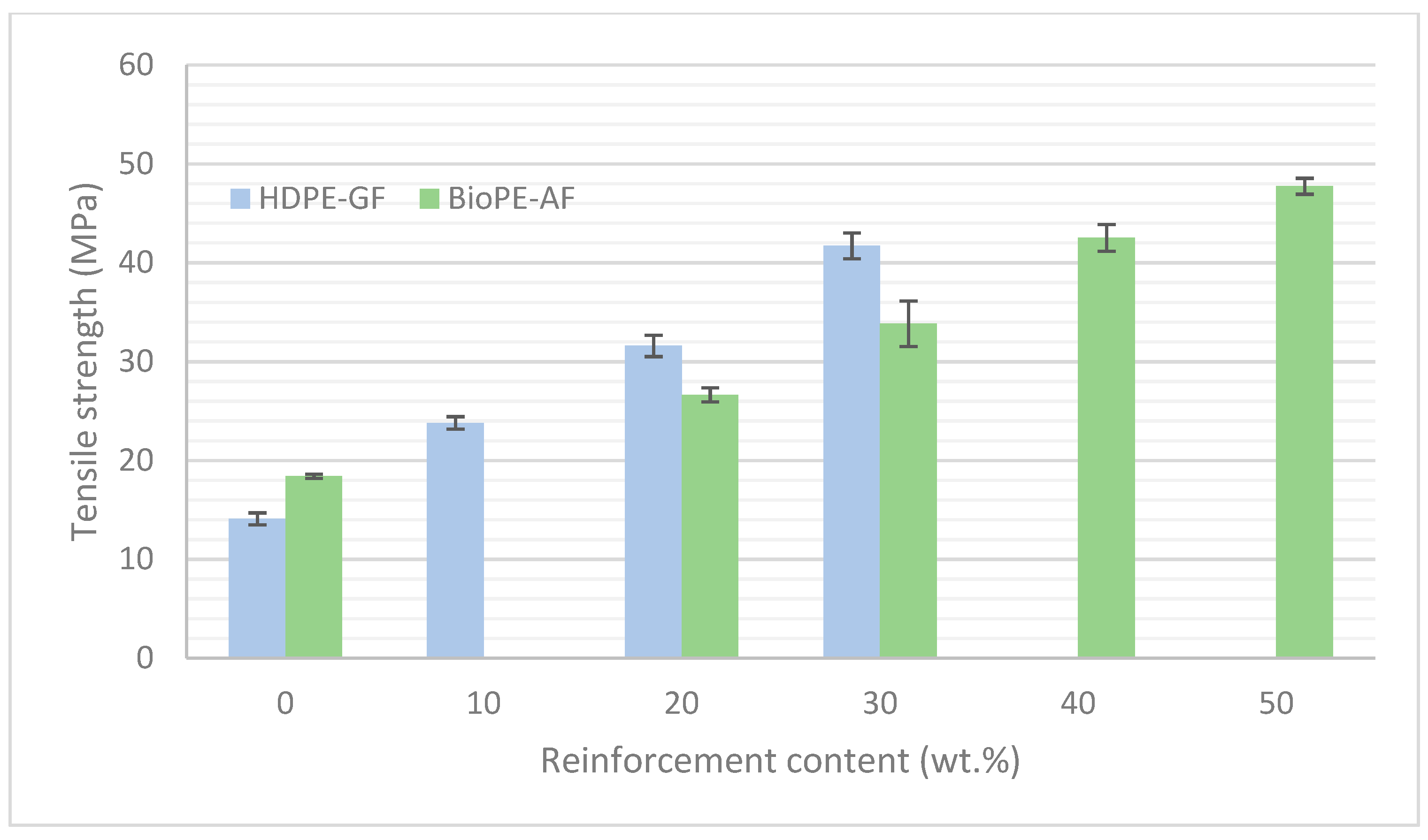
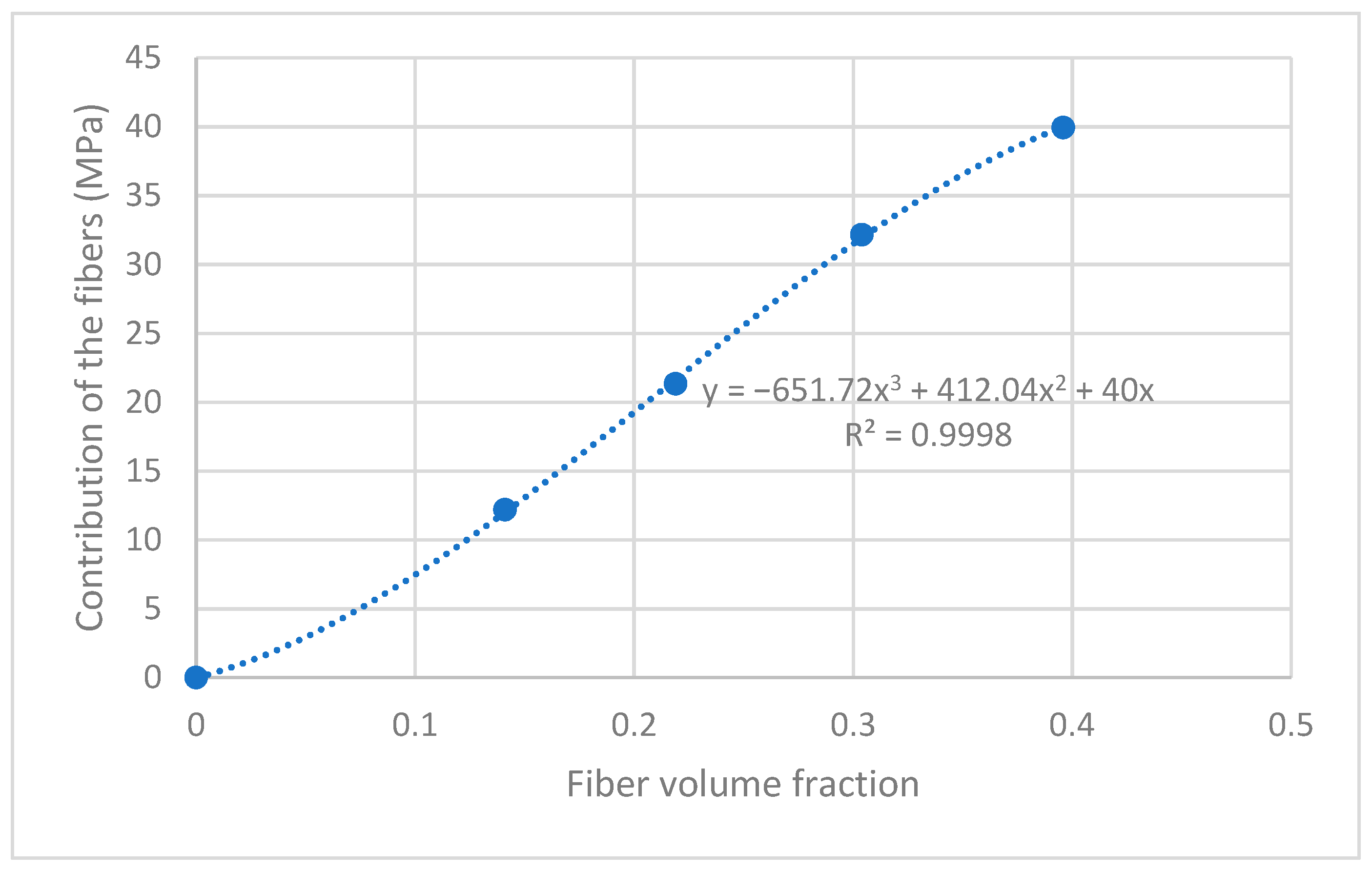
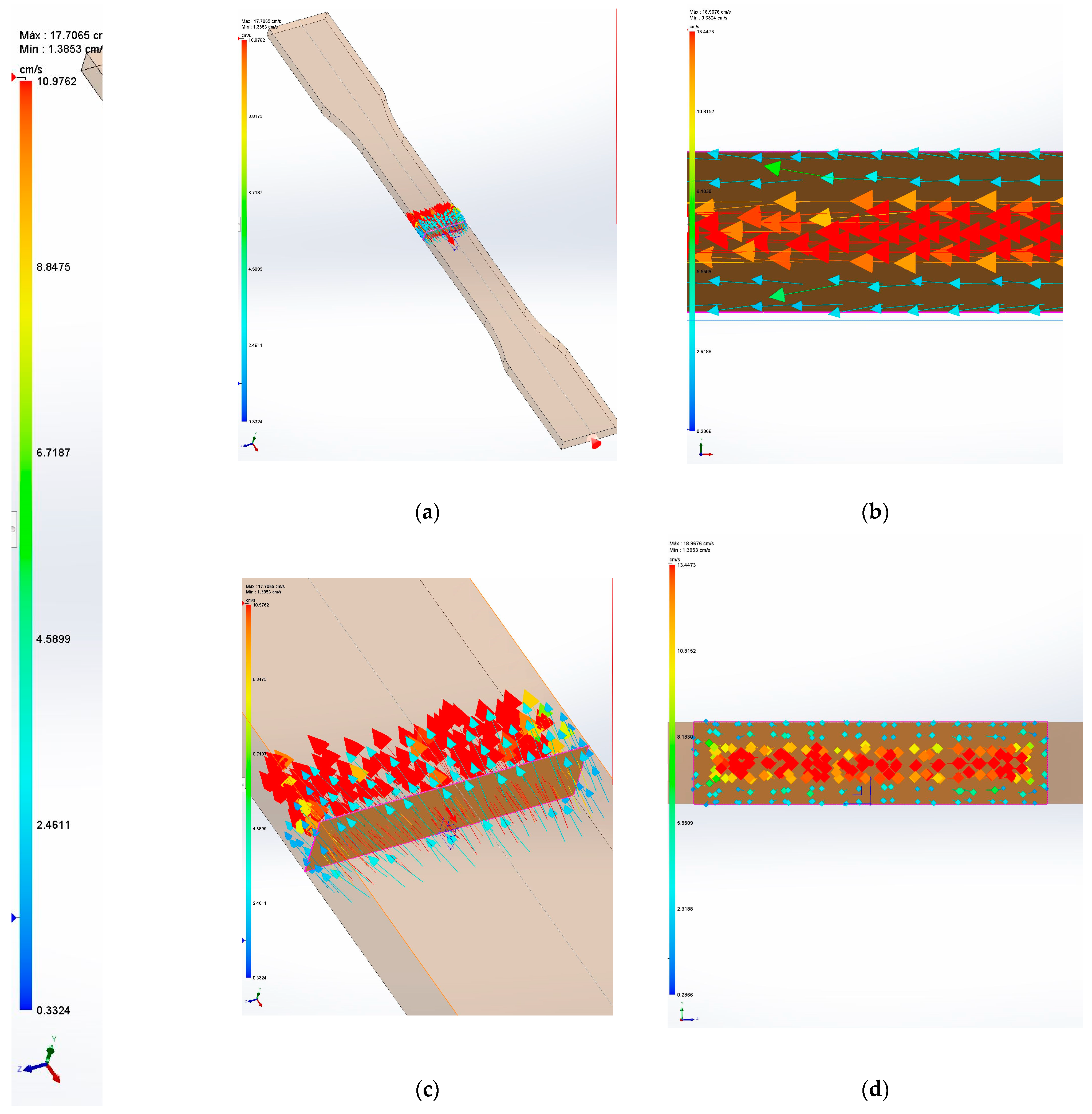
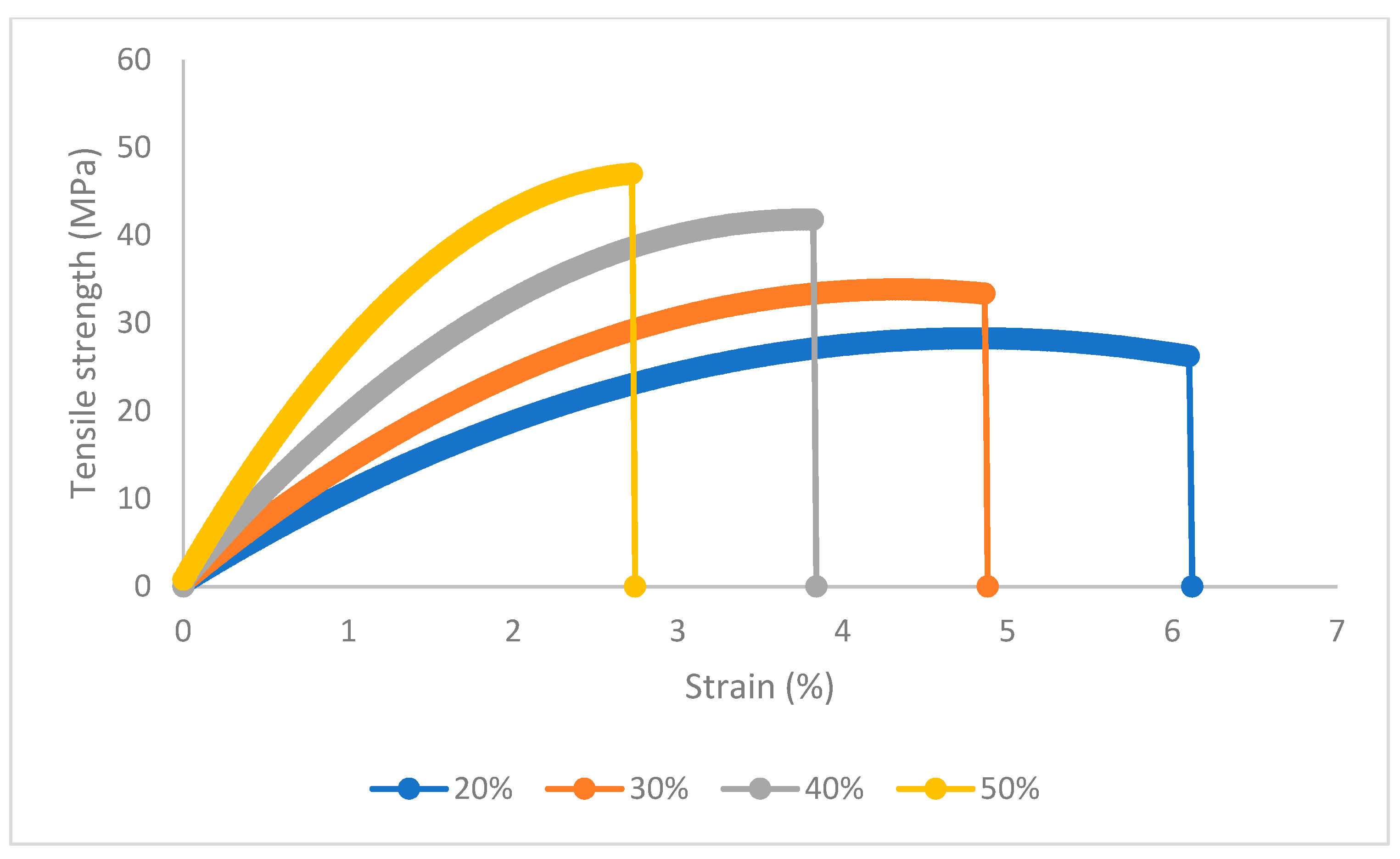
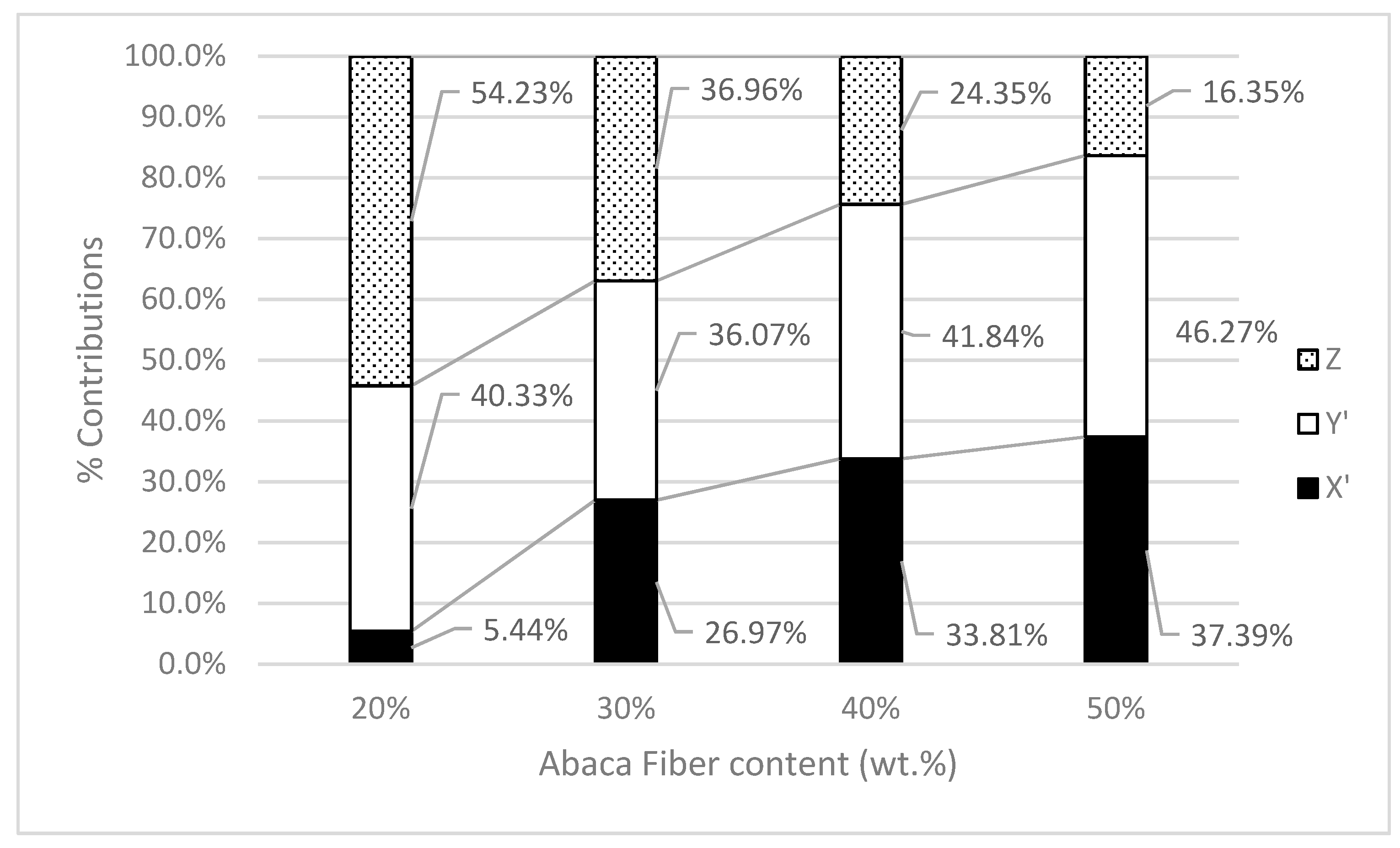
| AF Content (%) | MAPE Content (%) | VF | (MPa) | (GPa) | (%) |
|---|---|---|---|---|---|
| 20 | 8 | 0.141 | 26.64 ± 0.24 a | 3.25 ± 0.03 a | 6.10 ± 0.29 a |
| 30 | 0 | 0.219 | 22.46 ± 0.54 b | 3.47 ± 0.02 b | 3.18 ± 0.25 bc |
| 2 | 24.97 ± 0.26 c | 3.50 ± 0.06 bc | 3.24 ± 0.26 bc | ||
| 4 | 28.56 ± 0.70 d | 3.28 ± 0.02 cd | 3.72 ± 0.27 cd | ||
| 6 | 31.52 ± 0.23 ef | 3.74 ± 0.01 ef | 4.53 ± 0.30 de | ||
| 8 | 33.85 ± 0.77 h | 3.76 ± 0.04 f | 4.86 ± 0.20 e | ||
| 10 | 32.56 ± 0.36 fg | 3.64 ± 0.04 ce | 4.96 ± 0.21 e | ||
| 40 | 8 | 0.304 | 42.51 ± 0.45 i | 5.06 ± 0.01 g | 3.82 ± 0.26 f |
| 50 | 8 | 0.396 | 47.73 ± 0.27 j | 6.44 ± 0.11 h | 2.70 ± 0.13 g |
| GF Content (%) | VF | (MPa) | (GPa) | (%) |
|---|---|---|---|---|
| 10 | 0.041 | 23.8 ± 0.21 | 1.63 ± 0.01 | 5.1 ± 0.14 |
| 20 | 0.088 | 31.6 ± 0.36 | 2.78 ± 0.01 | 4.6 ± 0.08 |
| 30 | 0.143 | 41.7 ± 0.44 | 4.10 ± 0.01 | 4.3 ± 0.12 |
| AF Content (wt.%) | MAPE Content (wt.%) | (MPa) | (MPa) | (MPa) | |
|---|---|---|---|---|---|
| 20 | 8 | 16.81 | 86.53 | 480.7–432.6 | 0.18–0.20 |
| 30 | 0 | 15.12 | 48.64 | 0.09–0.10 | |
| 2 | 15.21 | 59.78 | 0.11–0.12 | ||
| 4 | 15.87 | 73.82 | 0.14–0.15 | ||
| 6 | 16.49 | 85.12 | 0.16–0.17 | ||
| 8 | 16.02 | 97.44 | 541.3–4872 | 0.18–0.20 | |
| 10 | 16.11 | 91.22 | 0.17–0.19 | ||
| 40 | 8 | 14.87 | 105.79 | 587.7–528.9 | 0.18–0.20 |
| 50 | 8 | 12.91 | 100.84 | 560.2–504.2 | 0.18–0.20 |
| AF Content (wt.%) | (µm) | 1 | 2 | 3 | |
|---|---|---|---|---|---|
| 20 | 0.598 | 567.6 | 0.150 | 0.179 | 0.209 |
| 30 | 0.603 | 532.4 | 0.150 | 0.181 | 0.211 |
| 40 | 0.603 | 498.3 | 0.151 | 0.181 | 0.211 |
| 50 | 0.608 | 475.5 | 0.152 | 0.182 | 0.212 |
| AF Content (wt.%) | 20% | 30% | 40% | 50% |
|---|---|---|---|---|
| Strain level 1 analyzed (%) | 2.01 | 1.60 | 1.27 | 0.89 |
| Strain level 2 analyzed (%) | 4.03 | 3.21 | 2.55 | 1.78 |
| Composite stress at strain level 1 (MPa) | 20.14 | 22.10 | 25.98 | 27.53 |
| Composite stress at strain level 2 (MPa) | 26.31 | 30.06 | 35.25 | 38.25 |
| Matrix stress at strain level 1 (MPa) | 11.10 | 9.69 | 8.32 | 6.42 |
| Matrix stress at strain level 2 (MPa) | 15.14 | 13.92 | 12.56 | 10.34 |
| Orientation factor | 0.29 | 0.31 | 0.25 | 0.35 |
| Interfacial shear strength (MPa) | 5.72 | 6.56 | 10.39 | 6.83 |
| Critical length (µm) | 1956 | 1835 | 1239 | 1501 |
| Intrinsic tensile strength (MPa) | 1148 | 1235 | 1321 | 1051 |
| AF Content (wt.%) | 20% | 30% | 40% | 50% |
|---|---|---|---|---|
| Orientation factor | 0.30 | 0.30 | 0.30 | 0.30 |
| Interfacial shear strength (MPa) | 10.42 | 10.42 | 10.42 | 10.42 |
| Critical length (µm) | 425.3 | 583.7 | 772.3 | 736.4 |
| Intrinsic tensile strength (MPa) | 454.5 | 623.8 | 825.3 | 787.0 |
| fc | 0.19 | 0.16 | 0.13 | 0.13 |
Disclaimer/Publisher’s Note: The statements, opinions and data contained in all publications are solely those of the individual author(s) and contributor(s) and not of MDPI and/or the editor(s). MDPI and/or the editor(s) disclaim responsibility for any injury to people or property resulting from any ideas, methods, instructions or products referred to in the content. |
© 2023 by the authors. Licensee MDPI, Basel, Switzerland. This article is an open access article distributed under the terms and conditions of the Creative Commons Attribution (CC BY) license (https://creativecommons.org/licenses/by/4.0/).
Share and Cite
Seculi, F.; Espinach, F.X.; Julián, F.; Delgado-Aguilar, M.; Mutjé, P.; Tarrés, Q. Evaluation of the Interface Strength in the Abaca-Fiber-Reinforced Bio-Polyethylene Composites. Polymers 2023, 15, 2686. https://doi.org/10.3390/polym15122686
Seculi F, Espinach FX, Julián F, Delgado-Aguilar M, Mutjé P, Tarrés Q. Evaluation of the Interface Strength in the Abaca-Fiber-Reinforced Bio-Polyethylene Composites. Polymers. 2023; 15(12):2686. https://doi.org/10.3390/polym15122686
Chicago/Turabian StyleSeculi, Faust, Francesc X. Espinach, Fernando Julián, Marc Delgado-Aguilar, Pere Mutjé, and Quim Tarrés. 2023. "Evaluation of the Interface Strength in the Abaca-Fiber-Reinforced Bio-Polyethylene Composites" Polymers 15, no. 12: 2686. https://doi.org/10.3390/polym15122686






